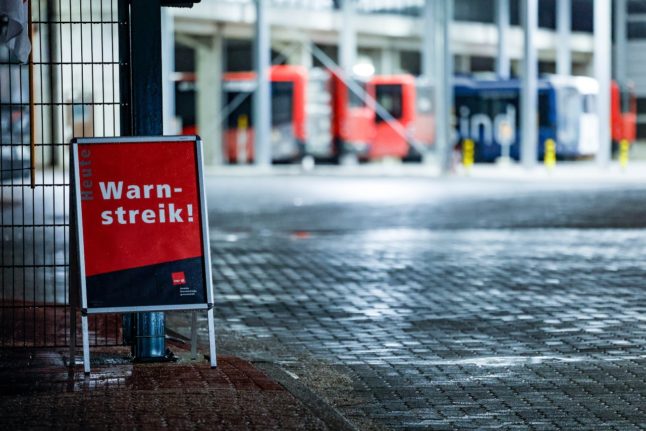The strike, which comes ahead of the second round of talks between Verdi and transport chiefs, will run all day and impact all major cities in North Rhine-Westphalia.
“The strike is on everywhere,” Peter Büddicker from the Verdi’s NRW branch told Tagesschau on Thursday.
However, transport services should be back to normal by Friday.
What services are affected?
The vast majority of local transport companies in NRW will be hit by the all-day strike action on Thursday, with cities like Düsseldorf, Dortmund, Cologne, Bonn, Bielefeld, Essen, Wuppertal and Münster all affected.
In Bonn, for example, the SWB, SWBD and SWBV will see severe disruption, along with the DSA in Dortmund, the Rheinbahn AG in Düsseldorf and the Kölner Verkehrs-Betriebe Aktiengesellschaft (KVBA) in Cologne.
READ ALSO: Why Germany is being hit by strikes almost every day
A number of smaller cities and towns across the state will also see their transport services come to a halt, including Hamm, Solingen, Bochum, Krefeld and Leverkusen.
Buses, trams and underground services will all be impacted.
A full list of the transport companies affected by the strike can be found here on the Tagesschau website, and regular updates and information on alternative routes will be provided on operators’ apps and websites throughout the day.
What services aren’t affected?
Since regional and S-Bahn services are run by Deutsche Bahn rather than local transport operators, this latest round of strike action won’t affect RE, RB and S-Bahn rail services. Intercity rail services like ICE, IC and EC trains are also excluded.
A handful of transport companies in NRW are also excluded from the walkouts, including ASEAG in Aachen, RVK in Cologne, RSVG in Troisdorf, OVAG in Gummersbach and Munster’s WVG Group.
That means that in cities like Munster a partial service will be running, with the Stadtwerke Münster out of operation while WVG runs. The situation is similar in Cologne, where KVBA workers are on strike but RVK workers aren’t.
What impact are the strikes having?
According to estimates by the Association of German Transport Companies, local transport companies in NRW transport an average of around five million passengers per day.
Since these are usually return journeys, it’s likely that around 2.5 million people travel daily on public transport in the region, many of whom were likely affected by Thursday’s industrial action.
In some cases, employees are given permission to work from home on strike days. However, compulsory school attendance remains in place for children.
Verdi is currently in the process on negotiating a new collective agreement for employees in local transport companies. Friday will see the second round of talks following the opening of negotiations in January.
READ ALSO: Where are the next public transport strikes taking place in Germany?
Among other things, the services union is pushing for better pay and more days off for workers.
Strikes are also due to be held in Lower Saxony on Monday and Tuesday.



 Please whitelist us to continue reading.
Please whitelist us to continue reading.
Member comments